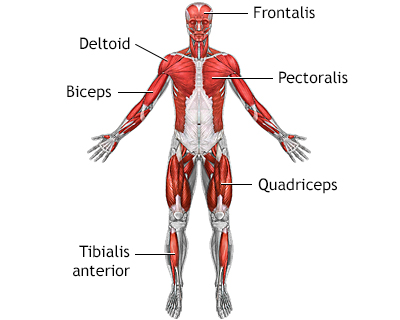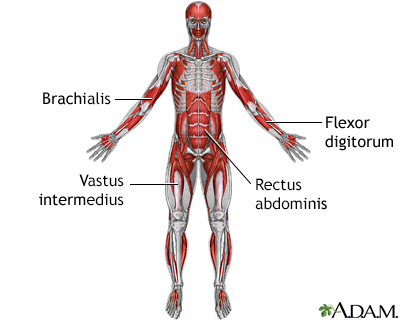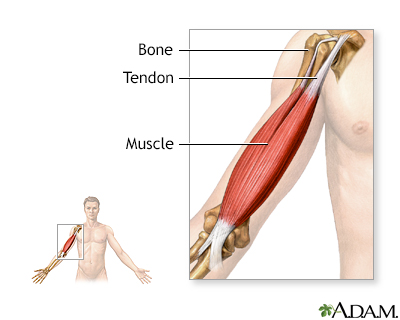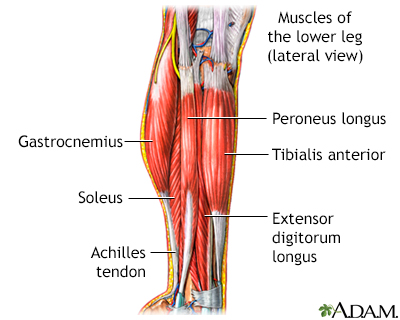Becker muscular dystrophy
Benign pseudohypertrophic muscular dystrophy; Becker's dystrophy
Becker muscular dystrophy is an inherited disorder that involves slowly worsening muscle weakness of the legs and pelvis.
Images




I Would Like to Learn About:
Causes
Becker muscular dystrophy is very similar to Duchenne muscular dystrophy. The main difference is that it gets worse at a much slower rate and it is less common. This disease is caused by a mutation in the gene that encodes a protein called dystrophin.
The disorder is passed down through families (inherited). Having a family history of the condition raises your risk.
Becker muscular dystrophy occurs in about 3 to 6 out of every 100,000 births. The disease is found mostly in boys.
Symptoms
Females rarely develop symptoms. Males will develop symptoms if they inherit the defective gene. Symptoms most often appear in boys between ages 5 and 15, but may begin later.
Muscle weakness of the lower body, including the legs and pelvis area, slowly gets worse, causing:
- Difficulty walking that gets worse over time; by age 25 to 30, the person is usually unable to walk
- Frequent falls
- Difficulty getting up from the floor and climbing stairs
- Difficulty with running, hopping, and jumping
- Loss of muscle mass
- Toe walking
- Muscle weakness in the arms, neck, and other areas is not as severe as in the lower body
Other symptoms may include:
- Breathing problems
- Cognitive problems (these do not get worse over time)
- Fatigue
- Loss of balance and coordination
Exams and Tests
The health care provider will do a nervous system (neurological) and muscle exam. A careful medical history is also important, because symptoms are similar to those of Duchenne muscular dystrophy. However, Becker muscular dystrophy gets worse much more slowly.
An exam may find:
- Abnormally developed bones, leading to deformities of the chest and back (scoliosis)
- Abnormal heart muscle function (cardiomyopathy)
- Congestive heart failure or irregular heartbeat (arrhythmia) - rare
- Muscle deformities, including contractures of heels and legs, abnormal fat and connective tissue in calf muscles
- Muscle loss that begins in the legs and pelvis, then moves to the muscles of the shoulders, neck, arms, and respiratory system
Tests that may be done include:
- Creatine phosphokinase (CPK) and other blood tests
- Electromyography (EMG) nerve testing
- Muscle biopsy
- Genetic test
- Echocardiogram and electrocardiogram (ECG)
Treatment
There is no known cure for Becker muscular dystrophy. However there are many new medicines currently undergoing clinical testing that show significant promise in treating the disease. The current goal of treatment is to control symptoms to maximize the person's quality of life. Some providers prescribe steroids to help keep a patient walking for as long as possible.
Activity is encouraged. Inactivity (such as bed rest) can make the muscle disease worse. Physical therapy may be helpful to maintain muscle strength. Orthopedic appliances such as braces and wheelchairs may improve movement and self-care.
Abnormal heart function may require the use of a pacemaker or defibrillator.
Genetic counseling may be recommended. Daughters of a man with Becker muscular dystrophy will very likely carry the defective gene and could pass it on to their sons.
Support Groups
You can ease the stress of the illness by joining a muscular dystrophy support group where members share common experiences and problems.
Outlook (Prognosis)
Becker muscular dystrophy leads to slowly worsening disability. However, the amount of disability varies. Some people may need a wheelchair. Others may only need to use walking aids such as canes or braces.
Lifespan is most often shortened if there are heart and breathing problems.
Possible Complications
Complications may include:
- Heart-related problems such as cardiomyopathy
- Lung failure
- Pneumonia or other respiratory infections
- Increasing and permanent disability that leads to decreased ability to care for self, decreased mobility
When to Contact a Medical Professional
Contact your provider if:
- Symptoms of Becker muscular dystrophy appear
- A person with Becker muscular dystrophy develops new symptoms (particularly fever with cough or breathing difficulties)
- You are planning to start a family and you or other family members have been diagnosed with Becker muscular dystrophy
Prevention
Genetic counseling may be advised if there is a family history of Becker muscular dystrophy.
Related Information
WeaknessDuchenne muscular dystrophy
Muscle atrophy
Cardiomyopathy
Intellectual disability
Community-acquired pneumonia in adults
Respiratory
References
Doughty CT, Amato AA. Disorders of skeletal muscle. In: Jankovic J, Mazziotta JC, Pomeroy SL, Newman NJ, eds. Bradley and Daroff's Neurology in Clinical Practice. 8th ed. Philadelphia, PA: Elsevier; 2022:chap 109.
Gloss D, Moxley RT III, Ashwal S, Oskoui M. Practice guideline update summary: corticosteroid treatment of Duchenne muscular dystrophy: report of the Guideline Development Subcommittee of the American Academy of Neurology. Neurology. 2016;86(5):465-472. PMID: 26833937 pubmed.ncbi.nlm.nih.gov/26833937/.
Manzur AY. Muscular dystrophies In: Kliegman RM, St. Geme JW, Blum NJ, et al, eds. Nelson Textbook of Pediatrics. 22nd ed. Philadelphia, PA: Elsevier; 2025:chap 649.
Selcen D. Muscle diseases. In: Goldman L, Cooney KA, eds. Goldman-Cecil Medicine. 27th ed. Philadelphia, PA: Elsevier; 2024:chap 389.
BACK TO TOPReview Date: 3/31/2024
Reviewed By: Joseph V. Campellone, MD, Department of Neurology, Cooper Medical School at Rowan University, Camden, NJ. Review provided by VeriMed Healthcare Network. Also reviewed by David C. Dugdale, MD, Medical Director, Brenda Conaway, Editorial Director, and the A.D.A.M. Editorial team.

Health Content Provider
06/01/2025
|
A.D.A.M., Inc. is accredited by URAC, for Health Content Provider (www.urac.org). URAC's accreditation program is an independent audit to verify that A.D.A.M. follows rigorous standards of quality and accountability. A.D.A.M. is among the first to achieve this important distinction for online health information and services. Learn more about A.D.A.M.'s editorial policy, editorial process and privacy policy. A.D.A.M. is also a founding member of Hi-Ethics. This site complied with the HONcode standard for trustworthy health information from 1995 to 2022, after which HON (Health On the Net, a not-for-profit organization that promoted transparent and reliable health information online) was discontinued. |
The information provided herein should not be used during any medical emergency or for the diagnosis or treatment of any medical condition. A licensed medical professional should be consulted for diagnosis and treatment of any and all medical conditions. Links to other sites are provided for information only -- they do not constitute endorsements of those other sites. © 1997- 2025 A.D.A.M., a business unit of Ebix, Inc. Any duplication or distribution of the information contained herein is strictly prohibited.
